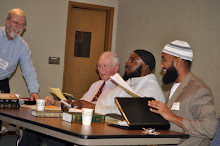Jerry Holt, Star Tribune
Champlin Park High School ninth-grader Keenan Hooper, 15, and school counselor Doyle Johnson had a friendly chat before the morning bell. Keenan was suspended often in middle school, but not once at the high school, where connecting with students and cutting suspensions are faculty priorities.
Black students are far more likely to be suspended from school than are their white classmates -- and Minnesota's disparity in suspensions is twice the national average. Why? What are the consequences?
By James Walsh, Star Tribune
Last update: May 18, 2008 - 12:35 PM
Featured comment
BALONEY !
It's "poverty"... it's "society"... it's the schools/teachers fault.... Doesn't anyone take responsibility for their actions any more ? I … read more grew up in a small town where everyone was poor. No one acted up, played thug, clown, or came to school with a chip on their shoulder. No one acted up.....Everyone graduated !
Add your own comment | Close comment
39 comments | See allPrint this story
E-mail this story
Save to del.icio.us
Share on newsvine
Share on Digg
Related Content
Audio slide show: About suspension – in their words
In their eyes, teachers too hasty in handing out punishment
Looking back: Some classroom lessons are clear
Getting to know kids is key to plan for improvement
Days at home for a 'sassy mouth'? Not in St. Paul
More from Lifestyle
A younger style of politics
Itsy-bitsy, teeny-weeny, yellow polka dot ... tankini?
Soap Opera Digest
Sound advice: Connecting subwoofer is easy
Makeovers: From drab to fab
Keenan Hooper likes to joke around and admits he has a motormouth. He also admits to getting into trouble again and again with teachers weary of his antics. School officials have sent him home more times than Keenan or his mom can count. ¶ So often, in fact, during his past couple years at Jackson Middle School in Champlin that he was referred to special education for a "behavioral disability" and saw his grades plummet.
This is not what Keisha Hooper wants for her son, who is black. She said she has asked how sending him away is helping.
"Teachers need order in the classroom, I agree," Keisha Hooper said. "I think where we part ways is that they seem to lose patience with the black kids more than they do the white."
Black students in Minnesota are being suspended at a rate about six times that of white students, according to a Star Tribune analysis of state Department of Education data. Some are sent home for serious misbehavior, like fighting or drugs. But most are suspended for lesser incidents, such as talking in class, goofing around or challenging teachers -- offenses for which there is more disciplinary leeway.
Black children across the country are suspended more often than whites. But Minnesota's suspensions disparity is twice the national average.
It's an issue evident in schools across the metro area.
In Osseo schools, black students make up 22 percent of the enrollment but 62 percent of the students suspended.
In Eden Prairie, where black enrollment is 9 percent, 41 percent of the students suspended were black.
And in Wayzata, 35 percent of the students suspended were black, while black students were 7 percent of enrollment. Every Minnesota school district with black students suspends them at rates higher than whites.
The consequences, educators say, are especially significant because Minnesota already has one of the nation's largest achievement gaps between black and white students, as measured by test scores and graduation rates. Kicking black students out of class may be widening that gap at a time when it's becoming increasingly important to close it, some educators say.
"You can't teach them if they are not there," said St. Paul schools Superintendent Meria Carstarphen, who has made cutting the number of suspensions -- especially those imposed for more subjective reasons -- a priority. "If you're really serious about closing an achievement gap, you have got to go deeper. You've got to bore deep [into suspensions]."
Many educators say the cause of the disparity is a complex web, with threads running from cultural differences to breakdowns in some families to evolving definitions of what's effective teaching.
"There's no simple answer to it. I'm not sure what to do about it," said Delroy Calhoun, executive director of Bethlehem Community Center in Minneapolis and a longtime educator. "Something's wrong."
But any effort to study why black children are suspended more than whites should include looking at how well a mostly white teaching corps connects with an increasing number of black students, school officials say.
Some fresh signs of success dealing with the issue are apparent in schools where teachers and administrators are newly committed to connecting with kids on a personal level and working with challenging students in the classroom.
"If kids believe that we love them and we are passionate about what we do, they want to work for that relationship," said Kate Maguire, assistant superintendent for leadership, teaching and learning in the Osseo schools. "When you have a roomful of students who look like you, perhaps those relationships are easier. When they are different, it makes the intentionality of building those relationships ever more important."
She added: "It's about assumptions that we all carry with us. ... But you have to get in there and work and listen and play with people who are different from you."
Zero tolerance
Minnesota law requires children be sent home for such things as bringing a weapon to school, for assault or for possessing drugs, Carstarphen said. And even kids acknowledge that they should be suspended for fighting.
In those cases, Carstarphen said, families and the broader community must play a role in curbing misbehavior. For many kids, how they act in school is an extension of what they're doing at home and in their neighborhood, she said.
"This is not just a school system problem," she said. "This is also about families being able to take more responsibility for their kids outside the classroom. We need all hands on deck if we really want to change this."
She added: "We absolutely should hold kids to those standards. It's not like we're trying to send the message that kids shouldn't be suspended if they bring a gun to school."
But of the nearly 40,000 Minnesota students suspended last school year, fewer than 3 percent were for bringing a weapon to school.
The most common reason for suspension in Minnesota is "disruptive behavior," a broad category that includes laughing during a test and running around in the classroom. And it may be the category in which the decisions of teachers and principals are most subjective.
At Hopkins West Jr. High, officials meted out 20 suspensions for "disrespect." In the Anoka-Hennepin schools, nearly 3,400 suspensions were handed down to middle school students for "disrespectful, insubordination or language" reasons. Of the more than 500 children in kindergarten through third grade who were suspended in St. Paul last year, half were sent home for behavior for which district policy does not require suspension.
"Teachers have to develop more tolerance. And the only way they can get that is through teacher training," said Roger Banks, a research analyst for the Council on Black Minnesotans. "Discipline is a teaching moment. This is where your abilities as a teacher come into play."
Statewide, nearly 15,000 students were suspended for disruptive behavior; another 2,300 were sent home for things they said. That's nearly a quarter of all suspensions. And 40 percent of those kids were black.
Suspending students for being loud does more harm than good, said Philip Miner, director of community initiatives for the Minnesota Private College Council.
"My greatest concern with the data is this: I am of the mind that if you separate a kid from the classroom, learning stops," Miner said. "When we overlay that reality with the demographic data that suggests too few students of color graduate from high school, how do you reconcile the fact that we are bumping so many kids out of class and breaking their link with academic progress?"
Sometimes, the question of suspending a student or not is more muddled.
Cashon Richard, 15, was suspended a few times in middle school. "But it got real crazy this year," said the Washburn High School ninth-grader.
This year, Cashon -- who says he's a gang member -- has been sent home several times for fighting. But he's also been suspended for being three minutes late to class, for going to the bathroom without a pass and for sleeping at his desk. In all, he guesses, he has been suspended 15 times this school year.
Eleanor Coleman, chief of student support services for the Minneapolis public schools, said district officials are working to cut suspensions and find ways to head off issues before a child must be sent home. But school officials sometimes must consider a "pattern of behavior" by students, in which serious incidents combine with more minor ones to disrupt learning for other students.
"Students don't often think about how their behavior impacts the rest of the class and other children's ability to learn," she said. "Maybe a school is trying to send a message to a child."
Said Cashon: "I think the teachers just don't like me."
DeShawn Richard, Cashon's 19-year-old brother, is a rising local rapper who said Cashon's teachers seem quicker to send him home than when DeShawn went to school. "It's not like he gets mad when he gets suspended; it's not really a punishment," he said. "He's at a point now where he feels that everybody's giving up on him."
Forging relationships
Brandi Stamper answers a visitor's questions with a small, hard-to-hear voice. She's seldom quiet any other time -- including at school.
The 14-year-old at North View Junior High in the Osseo schools has been suspended twice for turning up her volume. "I think some teachers don't like me because I'm kind of loud," she said.
There is one teacher -- Denise Rupert -- who Brandi says is firm, funny and patient, "as long as you don't disrespect her."
Brandi's mom, Sheila Stamper, said: "That's really what the kids are looking for, to be heard."
A postscript: Brandi was suspended again Thursday and Friday for getting into an altercation with a girl who knocked her books out of her arms. Sheila Stamper learned about the suspension through a phone message.
Rhoda Mhiripiri-Reed, the principal at Champlin Park High School, said her school is working to close the achievement gap and cut suspensions by better connecting with students. Last year, black students accounted for 43 percent of the suspensions at Champlin Park High School but 14 percent of its enrollment. On April 22, the school held a voluntary assembly for black students to talk about academics and discipline. The gathering of about 400 students included performances, poetry and a presentation by Mhiripiri-Reed on the achievement gap. Then a panel of top Champlin Park students who are black led a wide-ranging discussion. The assembly lasted nearly three hours.
In addition, a group of teachers, students and staff members meets twice a month to talk about ways to improve the school climate.
At a recent meeting, teacher Marika Belusa talked about adjusting to "cultural differences" between black students and white. One difference, she said: Black kids are often just louder than white kids.
Aaron Kane, a social studies teacher, grew up in an all-white town in Wisconsin and attended Winona State. Getting a job at Champlin Park, with its blend of urban and suburban kids, "was a new experience for me." For the past eight years, he has worked to get to know all of his students. If you know them, he said, you're less likely to send them out when there's an issue. When they know you, there are fewer issues.
"When I send a kid to the office, I not only have lost that kid for today, but maybe for three days," Kane said.
Several teachers in the group said that with increasing pressure to raise test scores, some teachers -- squeezed by time and rising class sizes -- find it easier to send loud, challenging kids out of the room rather than work with them. They've had teachers warn them about a "problem" student before a class even starts.
But, Belusa said, "It's the time of a student's life when you have the most influence. Yes, we're a microcosm of the larger community. But to me, it's important that we tell our students, 'We're not just looking at what color you are.' We have to teach hope."
This year, the number of black students suspended at Champlin Park has been cut almost in half, Mhiripiri-Reed said. "So there's improvement."
Improvement, too, for Keenan Hooper. The boy who was suspended more times than he could remember has not been sent home once since becoming a ninth-grader at Champlin Park. Watching him move through his classes, it's easy to see he still goofs around and still, sometimes, has a motormouth. He also seems to have better relationships with his teachers. He certainly has a good one with his principal.
"Keenan?" Mhiripiri-Reed said, when asked about how his year has gone. "He's adorable."
James Walsh • 651-298-1541
COMING MONDAY: A St. Paul school confronts the issue.
Continue to next page
Comment on this story | Read all 39 comments
Schools need options, not quotas.
Perhaps the most disturbing statement in the article is the Principal saying that they got to get their numbers of suspending children of color under target! WHAT??? So if a child of color beats the tar out of someone, and the school is over target for suspensions they can't / won't suspend them??? Who is the genius that thought up this one???
posted by davidrhaas on May 18, 08 at 6:10 pm |
16 of 17 people liked this comment.
re: baloney
ok so in small towns there's no problem because every one there "takes responsibilty for there for there actions" no one acted up, no one dropped out why does every do people ever leave "paradise" and move to the city? and of course no white children ever fight or are disruptive in school. why is the concept that sometimes children are treated unfairly so difficult to believe. look people there is prejudice in the world. until we admit it we can begin to deal with it. if the article had said more girls are suspended than boys would there be this outcry? examine the situation. if there is no truth to it move on. but if we find there is we must deal with.
posted by jayydubb on May 18, 08 at 6:44 pm |
1 of 10 people liked this comment.
For everyone who cries discrimination...
In reality, the most discriminated people in society is the whites. Everyone else wants everything handed to them because they feel they are owed everything. Think about this, if three black kids beat the tar out of a white, they get suspended and most likely the parents will cry foul, but if three white kids beat up a black kid, all of society will scream racism. I think in general the african american have a general lack of respect for everybody else that has been taught them by parents and the community, so it should be no surprise that they get into trouble more. Why should they be "tolerated" when there are other kids trying to learn!
posted by robtune on May 18, 08 at 7:12 pm |
9 of 11 people liked this comment.
a substitute teachers view
I taught for ten years after college in the late seventies and eighties. Two years ago I returned to teaching and taught in Columbus Nebraska. I moved back to the cities recently and have been subbing in area schools. The bigest thing I se is the disrespect i get form several of the students and it is almost always black female students that talk back when you ask them to be quiet. To say that black students are louder is not an excuse to except it. With the larger classes ( 35 or more in some cases) you find, because of a decrease in the number of teachers, any disruption is quickly magnified. The behavior i have witness would not be tolerated my any employer - why should teachers
posted by joblanch on May 18, 08 at 7:46 pm |
4 of 4 people liked this comment.
Bill Cosby's book offers some insight
60 years have passed and how many children have been raised since Equal Opportunity laws were brought about? What responsibility does the black community have to clean up it's own house and quit blaming the white folk? Bill Cosby's book tells it like it is.
Subscribe to:
Post Comments (Atom)


















































No comments:
Post a Comment